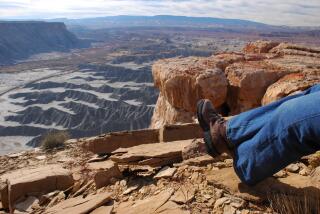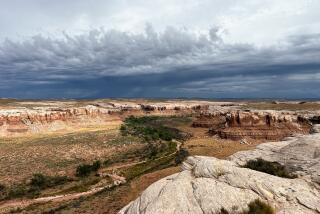Drilling Plans Encroaching on Wildlife Areas
ALONG THE CONTINENTAL DIVIDE, Wyo. — “Grizzly Bear Area, Special Rules Apply” screams the bright orange sign.
Riding atop North America’s burly shoulders, miles from the nearest pavement, outfitter Tory Taylor pats his holster.
Instead of carrying a six-shooter--this is the New West, after all--it holds a can of hot pepper spray. To deter danger, humanely.
Overhead, a golden eagle soars the thermals southeast of Yellowstone National Park. Beneath his boots, 30 miles of wild tumble all the way to the Tetons, still snowcapped in midsummer.
No “Ursus arctos horribilis” here. Although nobody can say they weren’t warned if one appears, snarling.
“Grizzlies tend to move at daylight and again in the evening,” Taylor says. “During the day, they head for the shade.”
But.
With grizzlies, there’s always a but.
“It all depends on how hungry they are,” he says, spurring his horse. “If their stomachs are empty, they’re liable to go anywhere.”
So are humans. That’s the problem.
America is hungry for fuel. And industry, backed by the Bush administration, wants to drill for oil and natural gas on almost 1 million acres of back country in the Shoshone and Bridger-Teton national forests--areas where the grizzly bear is largely free to roam.
The grizzly is listed as a threatened species--one step safer than endangered status, but still scarce and protected by law.
There are only 1,110 remaining in the Lower 48 states, a tiny fraction of the estimated 100,000 grizzlies that roamed the West in the 19th century. More than half of the survivors live in Yellowstone.
But they spend considerable periods roaming 4 million adjacent federal acres of peaks, dense timber and lush meadows--places that are prime bear country, but beyond the national park’s sheltering embrace.
National forests are working lands. Some oil and gas wells are already pumping in less-sensitive areas of the Shoshone and Bridger-Teton. Given the proper permits, petroleum geologists could go exploring many new spots before the snow flies.
If necessary, drilling supporters want to go all the way to the dizzying ridge in the Rocky Mountains where Taylor is riding.
“Looking at the energy crisis that we’re in, it’s irresponsible to withdraw an area from availability when there are known resources that can be recovered,” says Dru Bower, vice president of the Petroleum Assn. of Wyoming.
Opponents say the drilling plans are deliberately provocative.
In the Shoshone, for example, an exploratory well is proposed beneath Ramshorn Peak, where 15 of the bears have been tracked using radio collars, along with wolves, lynx and the northern goshawk, an endangered bird of prey.
“They know where the critical habitat is,” says Lloyd Dorsey of the Wyoming Wildlife Federation. “To say it is a coincidence they want to drill there would really be stretching it.”
Environmentalists fear that industrial development would bring the same result as a bullet.
Bears, they say, “always lose.”
“You’ll never see a grizzly in an oil field,” says Liz Howell of the Sierra Club.
Industry officials say they would tailor their work to comply with the Endangered Species Act and other regulations. But these federal lands are open to multiple uses, including commercial development and recreation. The U. S. Forest Service and other agencies are now deep into a bureaucratic evaluation of the problems that drilling poses.
Few creatures are considered more important in this corner than the grizzly, America’s largest land predator. An adult can weigh 900 pounds. Standing on its hind legs, it would dwarf 7-foot-1 basketball star Shaquille O’Neal.
Grizzlies have killed 17 people in the Lower 48 in the last century. However, they tend to be shy and rather high-strung, despite their huge bulk and ferocious reputations. Even distant noise can prompt them to abandon their dens, abort fetuses and suffer stress-related illness, scientists warn.
Their real conflict is with ranchers. In dry years, some bears risk capture and elimination by boldly venturing into the valleys to eat livestock.
Last year, 33 grizzlies were killed or found dead. Most were mistakenly shot by hunters; others either wandered onto highways or were destroyed by authorities for transgressions against humans.
The Bush White House has abandoned a Clinton administration plan to reintroduce 25 grizzlies into Idaho wilderness west of Yellowstone.
Interior Secretary Gale A. Norton has said she is “fully committed” to the bears’ survival, but won’t reintroduce them into new lands without community support.
Scientists say Norton’s decision dooms grizzlies to interbreeding in national parks and other “isolated islands of habitat.”
“Drilling could be the last straw that pushes imperiled wildlife like the grizzly to the edge of extinction,” Dorsey predicts.
All of which begs the question: How much energy is up here?
According to a 1995 assessment by the U. S. Geological Survey, 229 million barrels of oil are technically recoverable in the area of Wyoming immediately east of Yellowstone, including the Shoshone, known as the Sub-Absaroka Play.
It’s a modest reserve that even petroleum experts concede would be challenging to tap using today’s methods. If companies were to bore through volcanic rock, “they might hit something,” says Chris Schenk, project chief of the USGS assessment.
More appealing is the southern reach of the Bridger-Teton, closer to existing natural gas fields. One estimate suggests that parcels there might hold 80 trillion cubic feet of gas, enough to supply 1 million homes for decades.
Questions persist. How many wells? Would they be profitable? For how long?
There’s only one way to find out.
“We’ll never know what’s in there, under that ground, unless we’re allowed to drill,” says Don Likwartz, director of Wyoming’s Oil and Gas Conservation Commission.
After leasing, production would be delayed by several more years of additional studies and permits. Every drill site must be restored too.
“We can’t turn over a rock without approvals from several agencies,” says Bower of the Petroleum Assn.
Environmental groups pledge to seek an injunction to keep every rock right where it is.
“There will not be a well drilled unless a federal judge tells us so,” says attorney Tim Preso of Earthjustice, formerly the Sierra Club Legal Defense Fund.
“What we’re seeing in this little corner could play itself out across large parts of the West, particularly in critical wildlife strongholds.”
Industry officials complain that the public tug-of-war between precious energy and imperiled wildlife has turned into a distorted popularity contest.
It’s the latest in a series of public showdowns that have erupted in the Yellowstone region involving species considered to be emblems of the American West. Elk, bison, wolves--all have triggered bitter quarrels with landowners and ranchers, many of them smaller operators who have lived here for generations.
The prospect of energy drilling triggers a more visceral reaction. It’s big business, bringing roads, utilities, pipelines and waste pits to the back country.
“Resources are where they are,” Bower says. “We can’t decide where they should be located. Mother Nature doesn’t work that way.”
High on the Continental Divide, it’s hard to imagine industry coming this far, this high to the place that outfitter Taylor calls “a whole lotta yonder.”
From his saddle, he counts seven mountain ranges. Using his finger, he traces the ridgeline down to Union Pass, where the Atlantic and Pacific watersheds meet.
Up here, rainfall splits three ways to ride America’s great river systems--the Mississippi, the Columbia and the Colorado.
Taylor doesn’t look like an activist, or a cowboy. He wears a frayed mesh cap emblazoned with the logo of a fertilizer company. Smudged eyeglasses slide down his nose.
Looks deceive.
Budweiser named him its national Outdoorsman of the Year in 2000. Like a raindrop on Union Pass, Taylor split the $50,000 prize between several nature groups.
Along the trail, he points out hidden treasures to a dozen visitors.
A rotting log ripped open by a bear hungry for grubs. A splash of purple lupine wildflowers. The silhouette of an elk on a distant ridge.
Still, no grizzlies.
A few guests dismount to hike the final quarter-mile up Union Peak, elevation 11,491 feet.
The golden eagle suddenly dive-bombs. Its 7-foot wingspan casts a fearsome shadow. With talons flashing, it plucks a fat marmot from the rocks.
The astonished hikers stare as the eagle flaps homeward, dinner dangling, squealing. Then they erupt in animated re-creations of the wild moment.
Taylor fixes his gaze on the distant Tetons.
“Leave it alone,” he says.
“That’s the best use of this land.”
More to Read
Sign up for Essential California
The most important California stories and recommendations in your inbox every morning.
You may occasionally receive promotional content from the Los Angeles Times.










